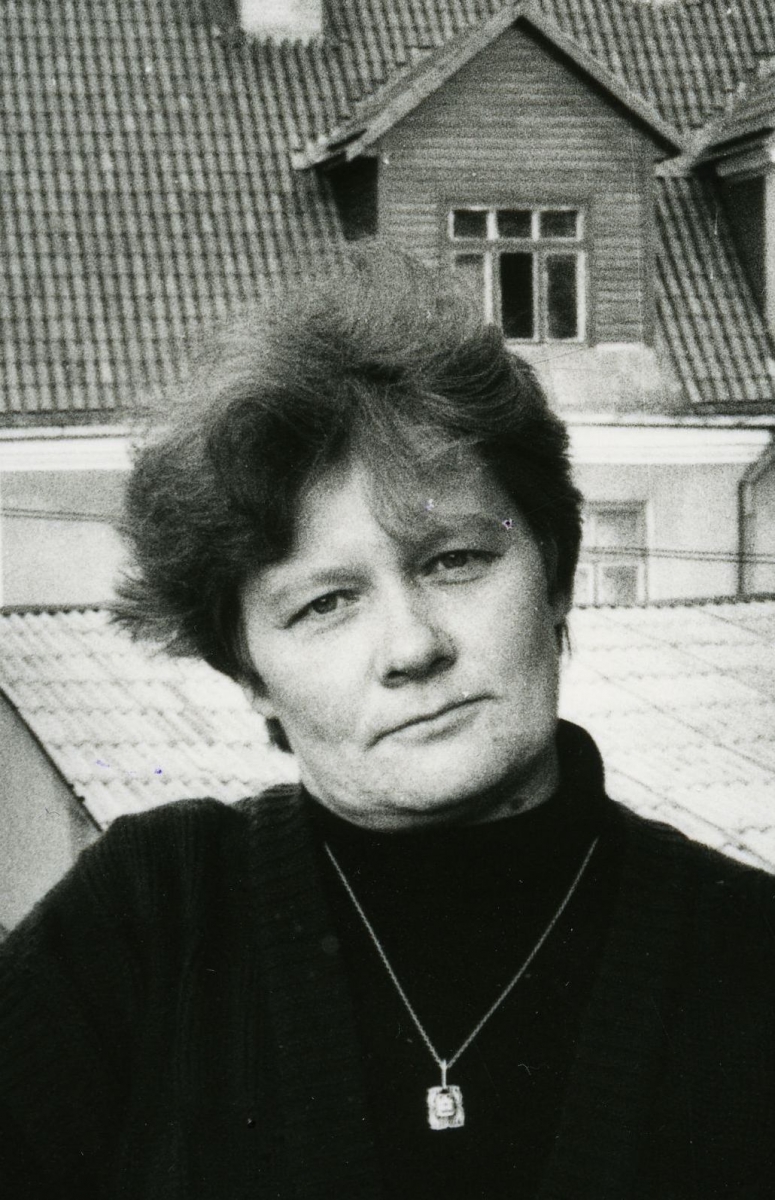
Ene Mihkelson
Ene Mihkelson (1944-2017) was an Estonian poet, prose writer and literary critic. Mihkelson’s literary aesthetics is considered one of the most original in Estonian literature. Her works focus on the individual’s complicated perception of reality, mostly in connection with painful events from personal life and the past of the Estonian people.
Ene Mihkelson was born in Imavere parish in Viljandi county, but went to school in and around Rakvere. In 1963 she graduated from Tartu University with a degree in philology and went on to work primarily as a researcher in the Estonian Literary Museum in Tartu. Mihkelson’s poems started to appear in the press from 1967 onwards, her literary criticism and research from 1971. Her first piece of prose (the short story Gregor) was published in the literary journal Looming in 1980. In 1976 Mihkelson was awarded the Looming annual prize for her poems and reviews. After the publication of her first two poetry collections, she became a professional writer and member of the Estonian Writers’ Union in 1979; after that, she gradually stopped publishing literary criticism and research papers. Mihkelson has twice won the Juhan Liiv Poetry Prize: in 1994 for the cycle of poems Eesti elu (‘Estonian Life’) and in 1999 for the poem “Ja ikka veel see tunne…” (‘”And still that feeling…”‘). Mihkelson’s literary research deals mostly with the works of Friedebert Tuglas. In 2001 she was awarded the Cultural Endowment Annual Award for Literature and in 2007 the Literature Endowment Annual Award for the novel Katkuhaud (‘Plague Grave’).
Even in her first collections of poetry – Selle talve laused (‘Sentences of this Winter’), Ring ja nelinurk (‘Circle and Square’), Algolekud (‘Primal States’), Tuhased tiivad (‘Wings in Ashes’) – Mihkelson’s pervasive themes already stand out: the search for the past, for self-expression, and for identity. In later collections – Tulek on su saatus (‘Coming is Your Destiny’), Elujoonis (‘Pattern of Life’), Võimalus õunast loobuda (‘Chance to Refuse the Apple’) – social subject matter is dealt with in greater depth: haunting personal memories are clearly linked to the shared past of the Estonian people. Intertextual dependence on classical texts increases. Hitherto free verse starts to acquire a personal rhythm and rhyme pattern. Later collections – Pidevus neelab üht nuga (‘Continuity is Swallowing a Knife’), Torn (‘Tower’) – also reveal a certain social irony.
The publication of Mihkelson’s prose works gave critics clearer guidelines on to how better to tackle her poetry. Characters in her novels provide a basis on which to analyse how painful and confused events from the past (from 1940s–1950s) influence the present and how they have fractured people’s sense of belonging and identity. In the modernist aesthetics of the novel, the line between external events and introspection gets blurred, dreams are bound up with reality. Events pass into contemplation about whether and how it is even possible to achieve certainty in acknowledging the past, oneself and one’s experience, and how it is possible to express it all in language.
Matsi põhi (‘Roots of a Rustic’, 1983) and the accompanying Kuju keset väljakut (‘Statue in the Middle of the Square’) stood out from the literature of the mundane of the period on account of their depth and innovation. The novel Korter (‘The Flat’, 1985) observes three characters living in a communal flat, offering a treatment of their fractured identities as a collective portrait of the Estonian state of mind. The novel Nime vaev (‘The Torment of a Name’, 1994) dissects the meaning of the contemporary transition years against the backdrop of the past. Ahasveeruse uni (‘The Sleep of Ahasuerus’, 2001) and Katkuhaud (‘Plague Grave’, 2007) tell relatively similar stories about how a first-person character explores his father’s guerrilla past. The past shrouded in shadowy confusion encounters in ‘The Sleep of Ahasuerus’ a contemporary attitude that is hostile, bureaucratic and superficial, and truth revealed is once again covered up. At the same time, the first person character painstakingly unravels the layers of his own world of feelings and thoughts. ‘Plague Grave’, in which the way Estonians think about the past is revealed in the title metaphor, tells the story with slightly simpler and more poetic means than her previous works.
I. S. (Translated by M. M.-K.)
Books in Estonian
Poems
Selle talve laused. Tallinn: Eesti Raamat, 1978, 99 lk.
Ring ja nelinurk. Tallinn: Eesti Raamat, 1979, 104 lk.
Algolekud. Tallinn: Eesti Raamat, 1980, 99 lk.
Tuhased tiivad. Tallinn: Eesti Raamat, 1982, 79 lk.
Igiliikuja. Tallinn: Eesti Raamat, 1985, 151 lk.
Tulek on su saatus. Tallinn: Eesti Raamat, 1987, 94 lk.
Elujoonis. Tallinn: Eesti Raamat, 1989, 133 lk.
Võimalus õunast loobuda. Tallinn: Eesti Raamat, 1990, 126 lk.
Hüüdja hääl. Luuletusi 1988–1991. Tallinn: Eesti Raamat, 1993, 212 lk.
Pidevus neelab üht nuga. Tallinn: Tuum, 1997, 157 lk.
Kaalud ei kõnele. Valitud luuletusi 1967–1997. Tallinn: Tuum, 2000, 299 lk.
Uroboros. Tallinn: Tuum, 2004, 96 lk.
Torn. Tallinn: Varrak, 2010, 102 lk.
Kõik redelid on tagurpidi. Valik luuletusi 1976–2010. Koostanud ja järelsõna: Hasso Krull. Tallinn: Eesti Keele Sihtasutus, 2016, 351 lk.
Novels
Matsi põhi. Tallinn: Eesti Raamat, 1983, 200 lk. [Sisaldab ka lühiromaani ’Kuju keset väljakut’. 2. trükk: ’Matsi põhi; Kuju keset väljakut; Korter’, Tallinn: Eesti Keele Sihtasutus, 2014, 492 lk.]
Korter. Tallinn: Eesti Raamat, 1985, 191 lk. [2. trükk: ’Matsi põhi; Kuju keset väljakut; Korter’, Tallinn: Eesti Keele Sihtasutus, 2014, 492 lk.]
Nime vaev. Tartu: Ilmamaa, 1994, 222 lk. [2. trükk: Tallinn: Eesti Keele Sihtasutus, 2014, 276 lk.]
Ahasveeruse uni. Tallinn: Tuum, 2001, 483 lk. [2. trükk: Tallinn: EKSA, 2017, 487 lk.]
Katkuhaud. Tallinn: Varrak, 2007, 319 lk. [2. trükk: Tallinn: Eesti Päevaleht, 2009, 303 lk; e-raamat: Tallinn: Varrak, Digira, 2011.]
Short stories
Surma sünnipäev. Novelle ja laaste. Tallinn: Tuum, 1996, 134 lk.
Non-fiction
Kirjanduse seletusi. Artiklid ja retsensioonid 1973–1983. Tallinn: Eesti Raamat, 1986, 204 lk.



